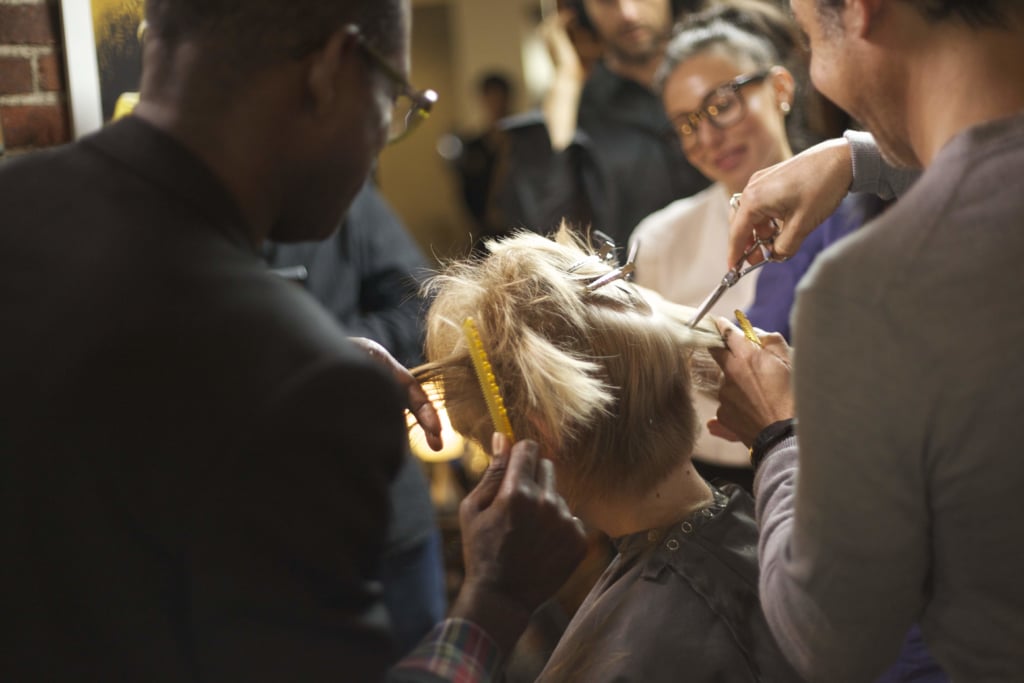Koki Tanaka, Theories of Behaviour Through Buckets
The artist draws on Japanese art history to develop a practice that is hyper contemporary, both in material and in matter.

‘A Haircut by 9 Hairdressers at Once (Second Attempt),’ 2010, Collaboration, video documentation (28 min), Zindagi Salon, San Francisco. Curator: Julio Cesar Morales, Commissioned by Yerba Buena Center for the Arts, San Francisco, Production photography: Tomo Saito,Participants: Victor A. Camarillo, Kristie Hansen, Nikki Mirsaeid, Olga Mybovalova, Sandra Osorio, Anthony Pullen, Brian Vu, Nicole Korth, Erik Webb, Karen Yee | photo courtesy of the artist, Vitamin Creative Space, Guangzhou and Aoyama Meguro, Tokyo
Artist Koki Tanaka works mainly with video, with many of his early works using a looping technique. Born in 1975, he is often described as an artist of his generation. Growing up through the fallout of the economic crash, his practice, down to his choice of materials, is conditioned by the social context within which he works. Many of his early pieces from the mid noughties would feature objects sourced from 100-yen stores. From these objects, he begins a critical investigation into perception and consciousness.
Many hands make light work
Later works, such as A Haircut by 9 Hairdressers at Once (2010), see the artist collaborate with teams of people, setting them to work on a single task as a collectivity. The piece unfolds as a sort of open-ended observed experiment, revealing the nature of routine behaviour and social relations between people. According to the artist speaking in an interview with Art It ‘the goal of the project is not to complete the task, per se, but rather to visualise the creative process.’
His practice may be acutely rooted in the contemporary, but he draws equally on the 1960s anti-art movement in Japan. Taking cues from the movement’s critical investigations into daily life, he scrutinises major events that are contemporary to him, including the 2011 tsunami and the ensuing Fukushima disaster. The anti-art movement provides just one reference among many for Koki Tanaka, whose practice is heavily influenced by Japanese post-war avant-garde art history, from Gutai to Mono-ha.
Whether the artist is staging himself in his video, performance, or installation work, as is characteristic of his early pieces, or calling upon the collaboration of others, a commitment to gesture remains, be it cutting hair, playing the piano, dropping buckets of water or hurling brooms. It is through these experimental and investigative processes that a reflection on community, society, and behaviour emerges.
A Haircut by 9 Hairdressers at Once (2010), an artwork by Koki Tanaka is available on his Vimeo channel.

‘A Haircut by 9 Hairdressers at Once (Second Attempt),’ 2010.
TRENDING
-
A House from the Taisho Era Reveals Its Secrets
While visiting an abandoned building, Hamish Campbell discovered photographs the owner had taken of the place in the 1920s.

-
The Taboo-Breaking Erotica of Toshio Saeki
The master of the 1970s Japanese avant-garde reimagined his most iconic artworks for a limited box set with silkscreen artist Fumie Taniyama.

-
With Meisa Fujishiro, Tokyo's Nudes Stand Tall
In the series 'Sketches of Tokyo', the photographer revisits the genre by bringing it face to face with the capital's architecture.

-
Masahisa Fukase's Family Portraits
In his series ‘Family’, the photographer compiles surprising photos in which he questions death, the inescapable.

-
Hajime Sorayama's Futuristic Eroticism
The illustrator is the pioneer for a form of hyperrealism that combines sensuality and technology and depicts sexualised robots.





